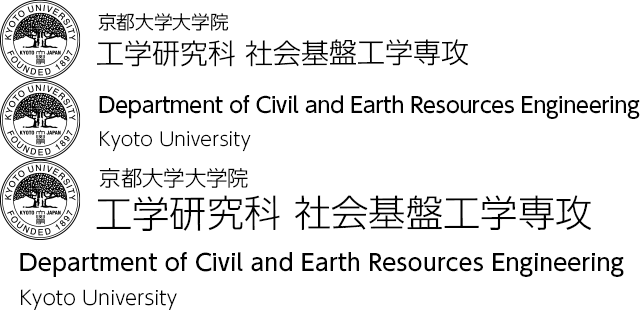Infrastructure Innovation Engineering
Researches in International Management of Civil Infrastructure Lab aim to ask questions in managing civil infrastructure systems whose answers are not yet clarified: developing effective methods to identify change in health condition of bridges and to make decision on the health condition; developing a smart sensor system specialized for health monitoring of short and medium span bridges. Noise and low-frequency vibrations radiated from bridges are another issues, and are examined by means of numerical simulations and field experiments. We also focus on nonlinear seismic behaviors of viaducts under traffic subject to severe ground motion, which is investigated by a newly developed analytical method that considers interaction of vehicle-bridge-ground motions.
Academic Staff
Chul-Woo KIM
 Professor (Graduate School of Engineering)
Professor (Graduate School of Engineering)
Research Topics
- Bridge health monitoring (BHM)
- Developing a smart sensing system for BHM
- Environmental vibrations caused by bridge vibrations
- seismic performance of viaduct under traffic
Contacts
Room 183, Bldg. C1, Katsura Campus
TEL: +81-75-383-3421
FAX: +81-75-383-3420
E-mail: kim.chulwoo.5u![]() kyoto-u.ac.jp
kyoto-u.ac.jp
Research Topics
Health monitoring of short and medium span bridges
More than 85 percent of bridges in Japan are classified as short and medium span bridges. A crucial issue in maintenance of those bridges, thus, is development of rapid and cost-effective tools for bridge health monitoring (BHM).
The research covers developing novel damage-sensitive features, fault detection by means of statistical pattern recognition and Bayesian approach, drive-by inspection, smart wireless sensor system and a novel unmanned aerial vehicle (UAV) for bridge inspection.
Figure 1 shows change in statistical pattern due to damage from damage experiment on a real truss bridge.

Figure 1. Scheme of statistical fault detection (left)/Damage experiment on a real truss bridge (middle)/ damage detection result (right).
Assessment of traffic-induced vibrations of bridges
The low frequency sound radiated from bridges under traffic is one of the environmental problems especially in land scarce major cities of Japan, since the low frequency sound can shake houses near the sound source and also can cause psychological and physiological influences to residents. If proper numerical or simulation methods to examine the low frequency sound of bridges are available, we can easily assess the low frequency sound and provide proper countermeasures through simulations.
The research aims to develop a general platform simulating traffic-induced vibrations that can even apply to assess the low frequency sound radiated from a viaduct.
Figure 2 shows simulated over all sound pressure level radiated from two-girder bridge as well as four-girder bridge. It demonstrates different trends of noise propagation according to bridge types.

Figure 2. Simulated sound propagation radiated from two-girder (top)/ four-girder bridges (bottom).
Seismic responses of viaducts under traffic and running safety of vehicles
Most highway bridge design codes do not consider the live load in seismic design of highway bridges because of the low probability of the two events of the critical live load and an earthquake occurring at the same time. Considering daily heavy traffic jam, however, there are possibilities to encounter an earthquake during a traffic jam in urban areas of earthquake prone regions. Therefore, even for highway bridges, the similar question, what is the seismic behavior of highway bridges considering vehicles on the bridge when subjected to earthquakes, is remaining to be solved.
The research is intended to investigate the seismic response of a highway viaduct under moving traffic loadings as well as stationary traffic loadings by means of a three-dimensional dynamic response analysis considering a bridge-vehicle interaction when subjected to severe earthquakes. Developing a platform to simulate the nonlinear dynamic response analysis under seismic and traffic. It also is useful to investigate the safety of running vehicles on the bridge during earthquakes.
Figure 3 shows phase between train and bridge during an earthquake, which led to reduction of bridge response in comparison with that considering train as mass. Those displacement responses in Figure 3 also clearly demonstrate the effect of train’s dynamic system to seismic response of the bridge.

Figure 3. Seismic responses of monorail train and bridges by simulation.
Drive-by Bridge Inspection
This challenging research project aims to develop a smart way to monitoring bridges, esp. short and medium span bridges, utilizing vehicle vibrations when the vehicle passes on the bridge. The idea is that utilizing the inspection vehicle as an actuator, data acquisition and message carrier, and extract information about bridge behaviors. Fig.4 shows the concept of the drive-by bridge inspection and laboratory experiment. Feasibility investigations demonstrated that feasibility of the proposed method to identify roadway surface profile and changes in bridge's dynamic characteristics due to damage as shown in Fig. 5.

Fig. 4: Drive-by Bridge inspection systems.

Fig. 5: Identified road surface profile and changes in damage index w.r.t. damage severity (INT: vehicle passing on the healthy bridge, DMG1 - DMG3: vehicle passing on the damaged bridge in which DMG3 denotes the most severe damage scenario).
